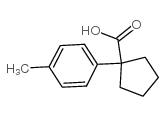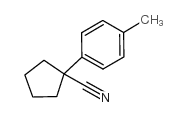80789-75-9
| 中文名 | 1-(对甲苯基)-1-环戊烷羧酸 |
|---|---|
| 英文名 | 1-(p-tolyl)-1-cyclopentanecarboxylic acid |
| 中文别名 | 1-(对甲苯基)-1-环戊羧酸 |
| 英文别名 |
RARECHEM AL BO 1151
1-(p-Tolyl)-1-cyclopentanecarboxylic acid 5GR MFCD00044672 1-(4-METHYLPHENYL)-1-CYCLOPENTANE CARBOXYLIC ACID EINECS 279-556-3 1-(p-Tolyl)-1-cyclopentanecarboxylic 1-p-tolyl-cyclopentanecarboxylic acid 1-(p-Tolyl)-1-cyclopentanecarboxylic acid1-(4-Methylphenyl)-1-cyclopentane carboxylic acid 1-(4-methylphenyl)cyclopentanecarboxylic acid 1-(p-Methylphenyl)cyclopentanecarboxylic acid |
| 密度 | 1.135 g/cm3 |
|---|---|
| 沸点 | 355.7ºC at 760 mmHg |
| 熔点 | 181-184ºC |
| 分子式 | C13H16O2 |
| 分子量 | 204.26500 |
| 闪点 | 165.6ºC |
| 精确质量 | 204.11500 |
| PSA | 37.30000 |
| LogP | 2.89140 |
| 外观性状 | 米色-淡灰色粉末和颗粒 |
| 折射率 | 1.5180 (estimate) |
| 储存条件 | 密闭于阴凉干燥环境中 |
| 稳定性 | 遵照规定使用和储存则不会分解。 |
| 分子结构 | 1、 摩尔折射率:58.34 2、 摩尔体积(m3/mol):179.8 3、 等张比容(90.2K):471.2 4、 表面张力(dyne/cm):47.1 5、 极化率(10 -24cm 3):23.12 |
| 计算化学 | 1、 疏水参数计算参考值(XlogP):3.2 2、 氢键供体数量:1 3、 氢键受体数量:2 4、 可旋转化学键数量:2 5、 拓扑分子极性表面积(TPSA):37.3 6、 重原子数量:15 7、 表面电荷:0 8、 复杂度:233 9、 同位素原子数量:0 10、 确定原子立构中心数量:0 11、 不确定原子立构中心数量:0 12、 确定化学键立构中心数量:0 13、 不确定化学键立构中心数量:0 14、 共价键单元数量:1 |
| 更多 | 1. 性状:无可用 2. 密度(g/mL,25/4℃):无可用 3. 相对蒸汽密度(g/mL,空气=1):无可用 4. 熔点(ºC):181-184 5. 沸点(ºC,常压):无可用 6. 沸点(ºC,5.2kPa):无可用 7. 折射率:无可用 8. 闪点(ºC):无可用 9. 比旋光度(º):无可用 10. 自燃点或引燃温度(ºC):无可用 11. 蒸气压(kPa,25ºC):无可用 12. 饱和蒸气压(kPa,60ºC):无可用 13. 燃烧热(KJ/mol):无可用 14. 临界温度(ºC):无可用 15. 临界压力(KPa):无可用 16. 油水(辛醇/水)分配系数的对数值:无可用 17. 爆炸上限(%,V/V):无可用 18. 爆炸下限(%,V/V):无可用 19. 溶解性:无可用 |
Synonym:1-(4-Methylphenyl)-1-cyclopentane carboxylic aci Section 2 - COMPOSITION, INFORMATION ON INGREDIENTS
Risk Phrases: 36/37/38 Section 3 - HAZARDS IDENTIFICATION EMERGENCY OVERVIEW
Irritating to eyes, respiratory system and skin. Potential Health Effects Eye: Causes eye irritation. May cause chemical conjunctivitis. Skin: Causes skin irritation. Ingestion: May cause gastrointestinal irritation with nausea, vomiting and diarrhea. Inhalation: Causes respiratory tract irritation. Can produce delayed pulmonary edema. Chronic: Effects may be delayed. Section 4 - FIRST AID MEASURES Eyes: Immediately flush eyes with plenty of water for at least 15 minutes, occasionally lifting the upper and lower eyelids. Get medical aid. Skin: Get medical aid. Flush skin with plenty of water for at least 15 minutes while removing contaminated clothing and shoes. Wash clothing before reuse. Ingestion: Never give anything by mouth to an unconscious person. Get medical aid. Do NOT induce vomiting. If conscious and alert, rinse mouth and drink 2-4 cupfuls of milk or water. Inhalation: Remove from exposure and move to fresh air immediately. If not breathing, give artificial respiration. If breathing is difficult, give oxygen. Get medical aid. Do NOT use mouth-to-mouth resuscitation. Notes to Physician: Treat symptomatically and supportively. Section 5 - FIRE FIGHTING MEASURES General Information: As in any fire, wear a self-contained breathing apparatus in pressure-demand, MSHA/NIOSH (approved or equivalent), and full protective gear. During a fire, irritating and highly toxic gases may be generated by thermal decomposition or combustion. Extinguishing Media: Use water spray, dry chemical, carbon dioxide, or appropriate foam. Section 6 - ACCIDENTAL RELEASE MEASURES General Information: Use proper personal protective equipment as indicated in Section 8. Spills/Leaks: Sweep up, then place into a suitable container for disposal. Provide ventilation. Section 7 - HANDLING and STORAGE Handling: Wash thoroughly after handling. Remove contaminated clothing and wash before reuse. Avoid contact with eyes, skin, and clothing. Avoid ingestion and inhalation. Use with adequate ventilation. Storage: Store in a tightly closed container. Store in a cool, dry, well-ventilated area away from incompatible substances. Section 8 - EXPOSURE CONTROLS, PERSONAL PROTECTION Engineering Controls: Facilities storing or utilizing this material should be equipped with an eyewash facility and a safety shower. Use adequate ventilation to keep airborne concentrations low. Exposure Limits CAS# 80789-75-9: Personal Protective Equipment Eyes: Wear appropriate protective eyeglasses or chemical safety goggles as described by OSHA's eye and face protection regulations in 29 CFR 1910.133 or European Standard EN166. Skin: Wear appropriate protective gloves to prevent skin exposure. Clothing: Wear appropriate protective clothing to prevent skin exposure. Respirators: A respiratory protection program that meets OSHA's 29 CFR 1910.134 and ANSI Z88.2 requirements or European Standard EN 149 must be followed whenever workplace conditions warrant respirator use. Section 9 - PHYSICAL AND CHEMICAL PROPERTIES Physical State: Solid Color: beige grey Odor: None reported. pH: Not available. Vapor Pressure: Not available. Viscosity: Not available. Boiling Point: Not available. Freezing/Melting Point: 182.00 - 183.00 deg C Autoignition Temperature: Not applicable. Flash Point: Not applicable. Explosion Limits, lower: Not available. Explosion Limits, upper: Not available. Decomposition Temperature: Not available. Solubility in water: Not available. Specific Gravity/Density: Not available. Molecular Formula: C13H16O2 Molecular Weight: 204.27 Section 10 - STABILITY AND REACTIVITY Chemical Stability: Stable at room temperature in closed containers under normal storage and handling conditions. Conditions to Avoid: Incompatible materials, excess heat, strong oxidants. Incompatibilities with Other Materials: Strong oxidizing agents. Hazardous Decomposition Products: Carbon monoxide, irritating and toxic fumes and gases, carbon dioxide. Hazardous Polymerization: Has not been reported. Section 11 - TOXICOLOGICAL INFORMATION RTECS#: CAS# 80789-75-9 unlisted. LD50/LC50: Not available. Carcinogenicity: 1-(p-Tolyl)-1-cyclopentanecarboxylic acid - Not listed by ACGIH, IARC, or NTP. Section 12 - ECOLOGICAL INFORMATION Section 13 - DISPOSAL CONSIDERATIONS Dispose of in a manner consistent with federal, state, and local regulations. Section 14 - TRANSPORT INFORMATION IATA Not regulated as a hazardous material. IMO Not regulated as a hazardous material. RID/ADR Not regulated as a hazardous material. Section 15 - REGULATORY INFORMATION European/International Regulations European Labeling in Accordance with EC Directives Hazard Symbols: XI Risk Phrases: R 36/37/38 Irritating to eyes, respiratory system and skin. Safety Phrases: S 24/25 Avoid contact with skin and eyes. WGK (Water Danger/Protection) CAS# 80789-75-9: No information available. Canada None of the chemicals in this product are listed on the DSL/NDSL list. CAS# 80789-75-9 is not listed on Canada's Ingredient Disclosure List. US FEDERAL TSCA CAS# 80789-75-9 is not listed on the TSCA inventory. It is for research and development use only. SECTION 16 - ADDITIONAL INFORMATION N/A |
|
生态学数据: 该物质对环境可能有危害,对水体应给予特别注意。
|
| 危害码 (欧洲) | Xi: Irritant; |
|---|---|
| 风险声明 (欧洲) | R36/37/38 |
| 安全声明 (欧洲) | 24/25 |
|
~55% 
80789-75-9 |
| 文献:Roberts, Donald D.; Arant, Mark E. Journal of Organic Chemistry, 1994 , vol. 59, # 21 p. 6464 - 6469 |
|
~% 
80789-75-9 |
| 文献:Journal of Organic Chemistry, , vol. 59, # 21 p. 6464 - 6469 |
| 上游产品 2 | |
|---|---|
| 下游产品 1 | |




